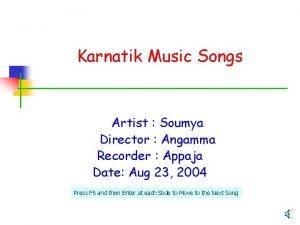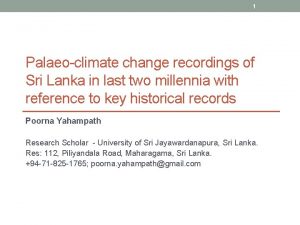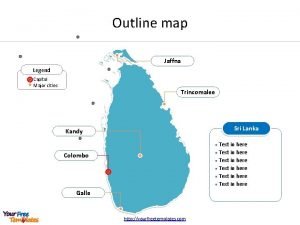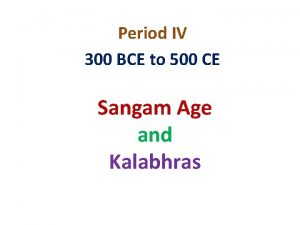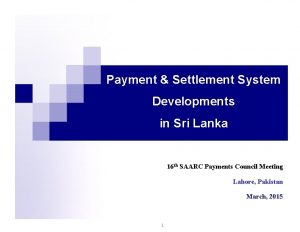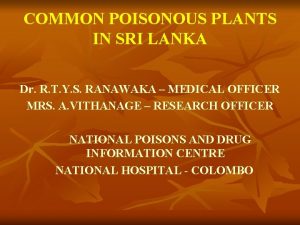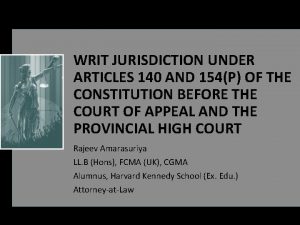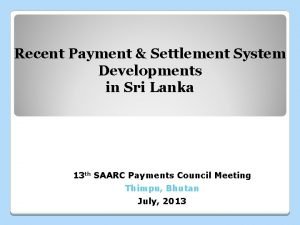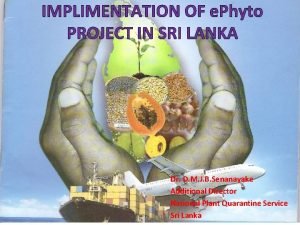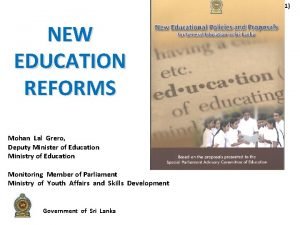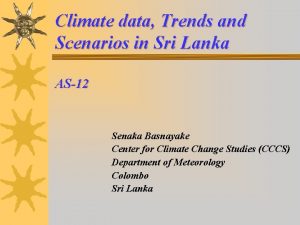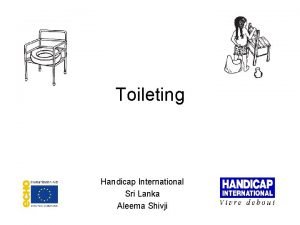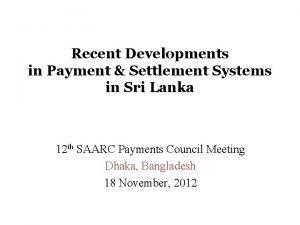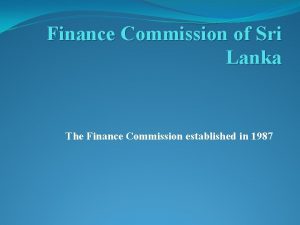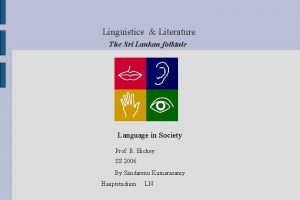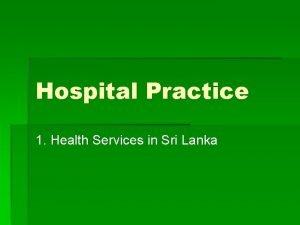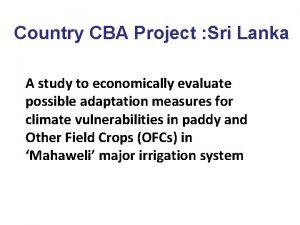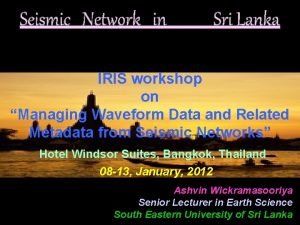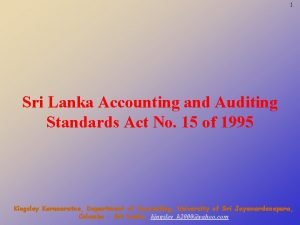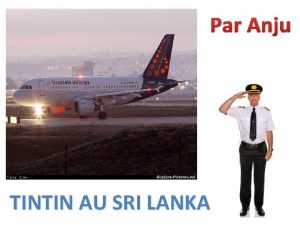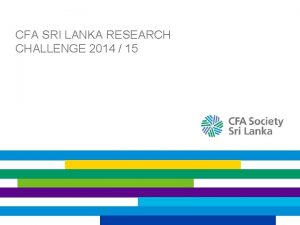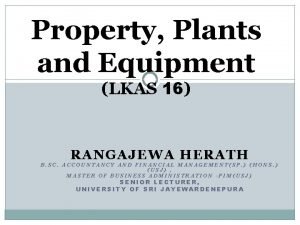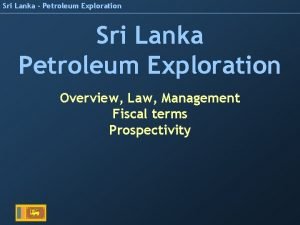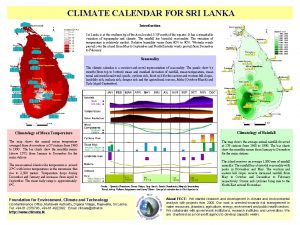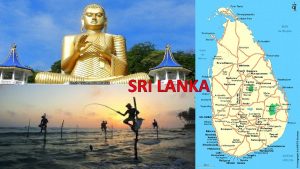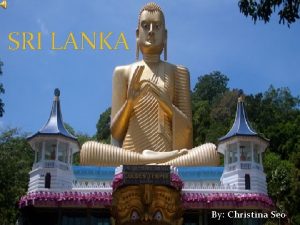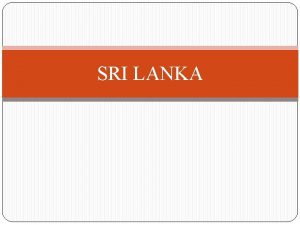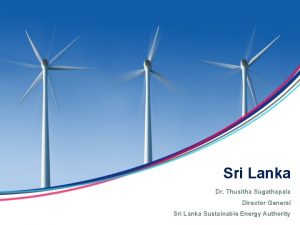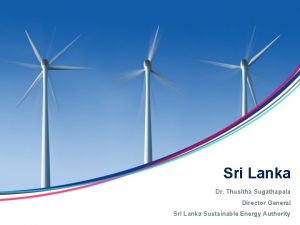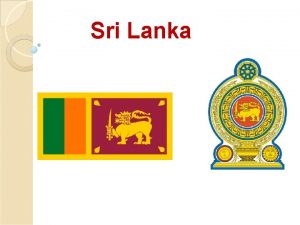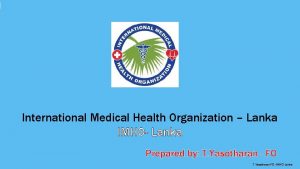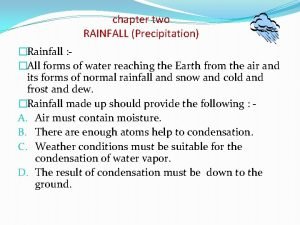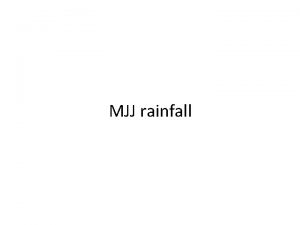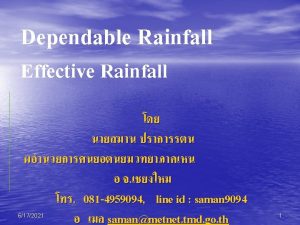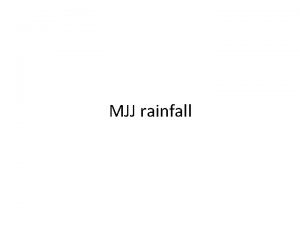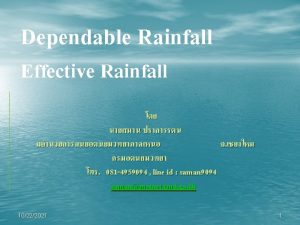Rainfall Temperature Scenarios for Sri Lanka under the









































- Slides: 41

Rainfall & Temperature Scenarios for Sri Lanka under the anticipated Climate Change B. R. S. B. Basnayake 1, Janaka Ratnasiri 2, J. C. Vithanage 2 1 Centre for Climate Change Studies, Department of Meteorology 2 Sri Lanka Association for the Advancement of Sciences AIACC Project - AS – 12 Sri Lanka

Outline. . n n n n Objectives Downscaling of GCM Baseline (1961 – 1990) climatology Observed Climate Change in Sri Lanka Temperature change Scenarios under the A 1 FI, A 2 & B 1 Scenarios with Had. CM 3, CGCM & CSIRO Rainfall change Scenarios under the A 2 Scenario with Had. CM 3 Conclusion

Objectives… Projection of Rainfall & Temperature Scenarios, which are applicable to Sri Lanka based on General Circulation Model (GCM) results

Downscaling of GCM ü ü ü Since Sri Lanka is an Island Resolution power of the grid points of the GCMs (300 km X 300 km) are not sufficient enough High diversity of altitude from sea level within short distance

Downscaling Tools n GCM Based Statistical Downscaling is used Pattern Scaling Method n Sim. CLIM Software - developed by IGCI, University of Waikato, New Zealand

Baseline (1961 – 1990) Climatology n ANUSPLIN Software – developed by Australian National University (ANU) is used to spatially interpolate the rainfall and temperature fields with terrain effect

Climatology of Sri Lanka

Climatological Seasons n First Inter-Monsoon (FIM) n n Southwest Monsoon (SWM) n n May – September Second Inter-Monsoon (SIM) n n March & April October & November Northeast Monsoon (NEM) n December – February

Baseline (1961 -1990) average Rainfall in Northeast Monsoon (NEM) Baseline (1961 -1990) average Rainfall in Southwest Monsoon (SWM)

Baseline (1961 -1990) average Rainfall in First Inter Monsoon (FIM) Baseline (1961 -1990) average Rainfall in Second Inter Monsoon (SIM)

1961 -1990 Baseline average Tmean in Northeast Monsoon 1961 -1990 Baseline average Tmean in Second Inter Monsoon

1961 -1990 Baseline average Tmean in First Inter Monsoon 1961 -1990 Baseline average Tmean in Southwest Monsoon

Observed Climate Changes in Sri Lanka




• temperature for the 1961 -1990 period is in the order of 0. 016 0 C per year.




Season Coefficient of Variation of all Sri Lanka Rainfall 1931 1960 – 1961 1990 Northeast Monsoon (Dec. to Feb. ) 31% 42% First Intermonsoon (Mar. to Apr. ) 23% 27% Southwest Monsoon (May. to Sep. ) 21% 16% Second Intermonsoon (Oct. to Nov) 22% 23% Annual (Jan. to Dec. ) 12% 14% - The Coefficient of Variation of all-Sri Lanka Rainfall during the periods 1931 -1960 and 1961 -1990.

Future Scenarios

General Circulation Models n n n Had. CM 3 CGCM CSIRO Emission Scenarios § A 1 FI § A 2 § B 1

Mean Temperature Change Scenarios in June 2100

Mean Temperature in June 2100 under the A 1 FI Had. CM 3 Mean Temperature in June 2100 under the A 2 Had. CM 3

Mean Temperature in June 2100 under the B 1 Had. CM 3

Mean Temperature in June 2100 under the A 1 FI CGCM Mean Temperature in June 2100 under the A 2 CGCM

Mean Temperature in June 2100 under the B 1 CGCM

Mean Temperature in June 2100 under the A 1 FI CSIRO Mean Temperature in June 2100 under the A 2 CSIRO

Mean Temperature in June 2100 under the B 1 CSIRO

Range of Mean Temperature Increment over the baseline in June 2100 Had. CM 3 CSIRO CGCM A 1 FI 2. 5 – 3. 0 2. 2 – 2. 4 2. 0 – 2. 2 A 2 2. 1 – 2. 5 1. 9 – 2. 0 1. 7 – 1. 8 B 1 1. 1 – 1. 4 1. 0 – 1. 1 0. 9 – 1. 0

Rainfall Change Scenarios in June 2100

Rainfall in June 2025 Under A 2 Had. CM 3 Rainfall in June 2050 Under A 2 Had. CM 3

Rainfall in June 2075 Under A 2 Had. CM 3 Rainfall in June 2100 Under A 2 Had. CM 3

Conclusions n n Projected Mean Temperature increases under different scenarios for different GCM models with varying magnitudes. Projected June Rainfall increases with Had. CM 3 under A 2 Scenario. The increments are much more higher on the western slopes of the central hills (windward side) compared to leeward side.

Acknowledgement n IGCI, University of Waikato, New Zealand is greatly acknowledged

Thank You




Station Topographical Location Coefficient of Variation (%) 1981 – 1990 1991 - 2000 Colombo Low Country 21% 20% Galle Low Country 28% 12% Ratnapura Low Country 23% 15% Kandy Mid Country 21% 22% Kenilworth Mid Country 37% 17% Talawakelle Up Country 28% 21% Nuwara-Eliya Up Country 26% 13% The Coefficient of Variation of southwest monsoon rainfall at selected stations in low, mid and up country regions during 1981 -1990 and 1990 -2000 periods (Basnayake and Punyawardane, 2003)
 Sri rama sri rama sri manoharama
Sri rama sri rama sri manoharama Collab sri lanka
Collab sri lanka Compare india and sri lanka on the basis of hdi
Compare india and sri lanka on the basis of hdi Beminitiya seya
Beminitiya seya English note grade 11
English note grade 11 Computer literacy in sri lanka
Computer literacy in sri lanka Map sri lanka capital
Map sri lanka capital Who is the primary deity of the sangam period
Who is the primary deity of the sangam period Payment and settlement system in sri lanka
Payment and settlement system in sri lanka Disaster management centre sri lanka
Disaster management centre sri lanka Mutiyanganaya
Mutiyanganaya Diya kaduru seeds
Diya kaduru seeds Tiep
Tiep Nigel barker sri lanka
Nigel barker sri lanka Bone marrow transplantation sri lanka
Bone marrow transplantation sri lanka Writ jurisdiction in sri lanka
Writ jurisdiction in sri lanka Payment and settlement system in sri lanka
Payment and settlement system in sri lanka Sri lankan vegetables
Sri lankan vegetables Maha ravana
Maha ravana Nvq levels in sri lanka
Nvq levels in sri lanka Corporate governance in sri lanka
Corporate governance in sri lanka Fumigation certificate sri lanka
Fumigation certificate sri lanka Mohanscience lk
Mohanscience lk Food and beverage industry in sri lanka
Food and beverage industry in sri lanka Agriculture insurance in sri lanka
Agriculture insurance in sri lanka Courseweb.sliit.lk
Courseweb.sliit.lk Climate data sri lanka
Climate data sri lanka Aleema shivji
Aleema shivji Sri lanka tea board elevation average
Sri lanka tea board elevation average Payment and settlement system in sri lanka
Payment and settlement system in sri lanka Finance commission of sri lanka
Finance commission of sri lanka Sri lanka folk tales
Sri lanka folk tales Administrative structure of health service in sri lanka
Administrative structure of health service in sri lanka Apartment ownership law sri lanka
Apartment ownership law sri lanka Cba sri lanka
Cba sri lanka Where is the seismometer in sri lanka
Where is the seismometer in sri lanka Sri lanka accounting and auditing standards act
Sri lanka accounting and auditing standards act Tintin in sri lanka
Tintin in sri lanka Sachille atapattu
Sachille atapattu Shotokan karate sri lanka
Shotokan karate sri lanka Lkas 16
Lkas 16 Labai. lk
Labai. lk
